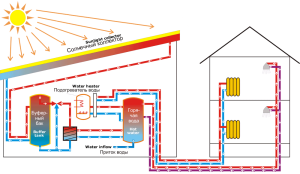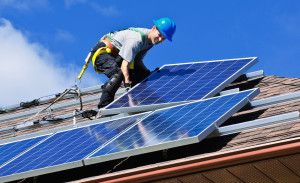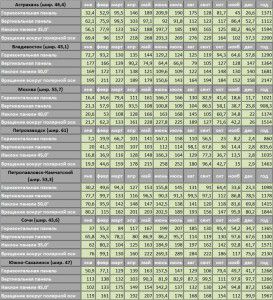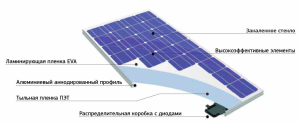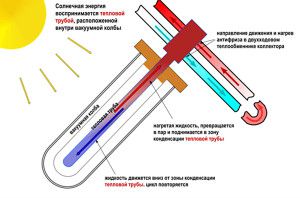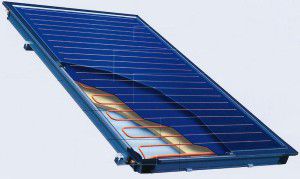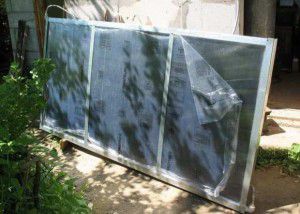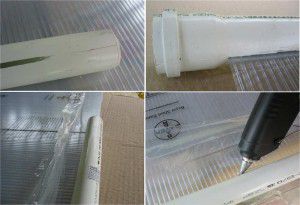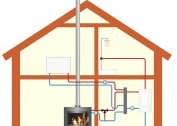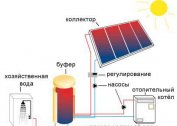How appropriate is it to use alternative sources of thermal energy for organizing heating? Currently, two types of heat supply are widespread - geothermal and solar systems. The latter is the most popular. How to make solar heating at home with your own hands: collectors, batteries and wiring diagrams?
Use of solar energy for heat supply
One of the determining principles for constructing any heating system is expediency. Those. all investments must pay off in a certain period of time. In this regard, heating a house with solar energy is the most efficient and financially profitable investment.
Solar energy is essentially a free source of heat. It can be used in several ways - to equip a heating system or to make an autonomous hot water supply system. If you carefully study the reviews about heating from solar panels - you can identify an interesting relationship. The more professionally made heating (factory collectors, additional heating, electronic control) - the higher the efficiency of heat supply.
What methods can transform solar energy into heat?
- Solar heater - as one of the ways to produce electrical energy. The radiation acts on the matrix of resistor photocells, resulting in voltage in the circuit. In the future, this current can be used to connect to heating appliances;
- Modern heating of a private house solar collectors. In this case, there is a direct transfer of thermal energy from solar radiation to the coolant. The latter is located in a piping system located in a special sealed enclosure.
The most effective is solar heating in the latter way. Thus, additional energy conversion can be avoided. The sun will directly affect the coolant, increasing its temperature. However, self-heating with solar energy using electric batteries is more versatile, since electricity can be used to operate other electrical appliances in the house. The choice is determined by the budget and the required system capacity.
During installation of the solar battery, a certain angle of inclination must be observed. Depending on the season, it should be 30 ° (summer) and 70 ° (winter).
The relevance of the organization of the solar system
Before purchasing or making the converter yourself, you should find out whether heating a private house with solar panels will be quite effective. For this, it is necessary to conduct a detailed analysis of all factors affecting the efficiency of the future system.
To begin with, the indicator of solar insolation is determined. This is the amount of solar energy falling on the surface of the earth in a particular region. The degree of heating of the coolant or the amount of generated current will depend on this. Solar radiators for home heating should ideally work regardless of the season. However, in fact, this is far from always the case.
Also, a passive solar heating system can change its operating efficiency due to the angle of the panel.It depends on the season. To determine the theoretically possible energy, you can use the data from the table.
Already on the basis of these data, it is possible to calculate the solar collector for heating, taking into account its technical and operational characteristics. But besides this, the following factors should be considered:
- House location. Natural or artificial objects should not impede the fall of the sun's rays - mountains, tall houses, high forest, etc.
- Place to install. Combined solar heating will require a large space - from 2 to 10 m². Most often, the roof of the house is used for this. Moreover, it must be adapted for the installation of collectors or solar panels;
- Heat output required. Often, solar heating systems of a private house are used as auxiliary.
Only after this analysis can we start choosing a specific alternative heating scheme for the house. Heat losses in the house are preliminarily calculated, the optimal thermal mode of heating is determined. If the solar collector in the heating system is auxiliary, the same indicator of the main heat supply system is added to its rated power.
When calculating, you need to consider the mass of equipment. The roof surface must withstand this load.
Solar panels for heating
Confusion often occurs - solar collectors are also called batteries. But in practice, the first type of equipment is most often used to organize heating of the house with solar energy.
The principle of heating a private house with solar panels is to convert thermal energy into electrical energy. For this, the following components are provided in the panel design:
- Photocells. When sunlight enters them, the formation of the so-called photocurrent occurs;
- Protective transparent case. Prevents damage to photocells;
- Electric current converters - inverters, transformers, batteries, etc.
Those. In fact, a solar heating battery is a great charger. First of all, it is designed to produce cheap electrical energy. Its use as one of the heating elements is impractical. For heating a house of 60 m² with a normal rate of insulation, 6 kW of heat energy per hour will be required. A standard solar heating battery measuring 284 * 254 mm has a specific power of 5 W / h. Those. To ensure heat supply, a battery coverage of 82 m² is required.
As can be seen from the calculations, this is more than impractical. That is why they prefer to make a solar collector for their own heating or to purchase factory settings.
Instead of heating a private house with solar panels, they can be used as a source of cheap electricity for low-power household appliances.
Choose a solar collector
For efficient heating operation using solar energy, the installation of collectors is recommended. They represent a system of pipelines through which the coolant flows. For protection and better focusing of solar energy, the design is protected by a transparent glass panel.
To increase the effective operation of the equipment, various types of coolant can be used in it, which will not change their properties under the influence of negative temperatures. This is important for regions with cold winters. In addition, it is necessary to carefully analyze the offers on the market and choose the optimal design.
Currently, manufacturers offer several ways to organize heating of a private house by solar collectors:
- Vacuum collector. The best option for organizing a passive solar heating system. They are characterized by an almost complete absence of heat loss;
- Flat collector. An economical option for solar heating. They are a system of pipes protected by a transparent material. Most often used for hot water in the summer. Application for combined solar heating requires taking into account the temperature schedule in the winter and a careful choice of coolant.
The choice is largely determined by preliminary calculations - the required power and frequency of heat supply. As an economy option, you can consider the possibility of self-production of flat collectors for heating with solar energy with your own hands.
When choosing a wiring diagram, the area of the structure must be taken into account. She will have a certain indicator of windage.
Vacuum manifolds for heating
One of the problems of operating solar radiators for heating a house is a large heat loss. They are due to the peculiarities of operation - the panel must be located outside the heated room to absorb solar energy. To solve this problem, a vacuum solar collector for the heating system was developed.
The design of the vacuum manifolds consists of an external casing and an internal system of glass pipes. For better insulation, the pipelines are separated from the external environment by a vacuum layer with discharged air. In fact, the entire installation is a large transparent thermos.
The specifics of the vacuum solar collector in the heating system is as follows:
- The use of a special fluid with a low boiling threshold as a coolant. In this case, a more efficient transfer of thermal energy through the heat exchanger to the main heating medium - water;
- Application of a special coating on the inner surface that increases the absorption capacity of thermal solar energy;
- Independence of work from external air temperature.
For the normal functioning of the system, it will be necessary to provide reliable thermal insulation of the heat exchanger. You should also insulate the pipeline in places passing through unheated rooms - an attic, a roofing pie. To calculate the solar collector for heating, standard schemes can be used. But it must be borne in mind that its operation will be ineffective when the temperature of the coolant in the circuit decreases to + 22 ° C.
In winter, it is necessary to clean the surface of the collector from the snow cap. Therefore, you need to think in advance of a way to complete this event.
Flat solar collectors for heating
To create a solar heating system for a private house with minimal cost, flat collectors are most often installed. They differ from vacuum in a simplified design. However, this increases the requirements for their operation.
The flat collector also has an internal piping system. However, it is made from copper or polymer pipes. For protection, polycarbonate or tempered glass is used. The internal surface is insulated with a heater - mineral wool or polystyrene. Under the influence of sunlight, the tubes heat up and, as a result, the temperature of the coolant rises.
For a flat solar collector in the heating system, there are strict operational restrictions:
- Only antifreeze can be used as a heat carrier. Otherwise, freezing of water and destruction of the pipeline will occur;
- For better circulation during heat transfer, installation of a pump is necessary;
- At temperatures below -10 ° C, the efficiency of the system drops significantly.
Due to the latter factor, it is not recommended to organize the heating of the house with solar energy using flat collectors in regions with low temperatures in the winter. Therefore, most often they make a flat solar collector for do-it-yourself heating for hot water supply in the summer, spring or autumn.
Experts recommend making heat supply using solar energy based on flat collectors only in the southern regions of the country with relatively warm winters.
DIY collector
It should be noted right away that a collector with its own hands will not work to ensure solar heating. To do this, use the production design of the vacuum structure discussed above. But at home it is almost impossible to make it due to the lack of necessary equipment and supplies. Therefore, we consider one of the simplest methods for manufacturing a solar heating battery for hot water supply.
For production, the following consumables will be required:
- Honeycomb Polycarbonate Sheet. For hot water supply of a summer house or a small house with the help of a solar collector for self-heating, a sheet 2 * 1 m in size will be enough;
- PVC pipe fittings and flexible hoses. With their help, a system of circulation of heated water and its supply to the consumer will be made;
- Frame profile for drywall and polystyrene sheets. They are necessary to create a protective housing in a passive solar heating system.
Honeycombs should be placed horizontally to better heat the water. Then, longitudinal sections are made in the PVC pipes. Heated water will flow from a polycarbonate sheet. In the obtained sections, a sheet is installed. He should not go into the pipe until it stops.
Using a heat gun, the joints are insulated. Without this tool, there is a high probability of leaks in the heating and domestic hot water supply by the solar collector. Before installation in the frame, it is imperative to conduct a leak test of the structure. To do this, it should be filled with water and visually check for leaks.
For the manufacture of the frame, galvanized profiles for drywall will be required. They will perform protective functions similar to the case of a solar radiator for heating the cottage. A layer of insulation is installed under the polycarbonate sheet, then a solar collector made by itself lies down. For more efficient heating, it is recommended that the sheet be painted black.
When calculating the solar collector for heat supply, the position of the sun at a certain point in the day is taken into account. The greatest efficiency is achieved when the angle of incidence of the rays is strictly perpendicular to the surface of the structure.
The best option is to use solar heating systems of a private house as auxiliary. For best performance, it is recommended that you install a thermal battery. The water in it will be heated from the collector during the day, and in the dark the accumulated thermal energy will be transferred to the main coolant in the system.
The video shows an example of manufacturing a solar collector from polymer pipes:
